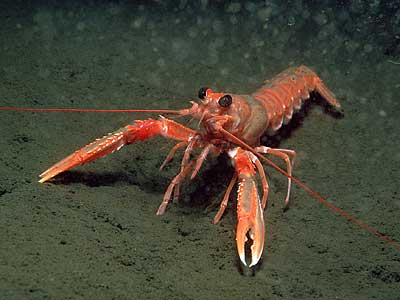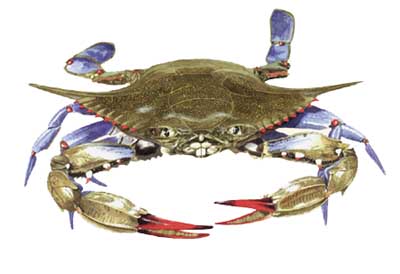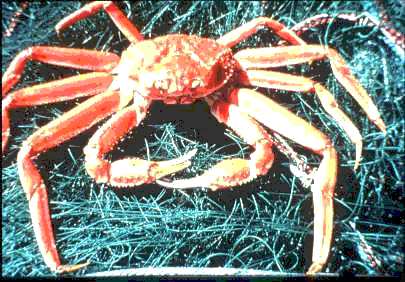Hosts
TAKEN FROM STENTIFORD & SHIELDS, 2005
Hematodinium infections have been reported from several crustacean hosts from around the world, with the majority of infections reported in brachyuran crabs (Table 1). The broad range of brachyuran hosts suggests that these parasites are host generalists, with perhaps some species infecting different classes of Crustacea (Amphipoda and Decapoda), but tests of host specificity await refinements in molecular tools. The Hematodinium-like parasite from the spot prawns, Pandalus borealis and P. platyceros (Bower et al. 1993; Meyers et al. 1994, Bower & Meyer 2002) is apparently more closely allied with the Haplosporidia and is not a dinoflagellate (Reece et al. 2000).
Hudson & Shields (1994) and Shields (1994) have speculated that amphipods may act as alternate or reservoir hosts for Hematodinium. Small (2004) recently showed that PCR primers specific for Hematodinium in N. norvegicus also amplify products from amphipods. While these primers indicated that the parasite in amphipods was a species of Hematodinium, they are likely genus specific, making it difficult to draw further conclusions. However, since crustaceans, including amphipods, make up a significant portion of the diet (up to 25%) of juvenile C. sapidus, C. opilio and even N. norvegicus, , and since amphipods reportedly carry a similar infection (Johnson 1986, Small 2004), then their role in transmission of the disease needs to be investigated. Infection trials exposing amphipods to infected tissues or carcasses of infected crabs or lobsters may provide insight into the life cycle of the parasites and potentially elucidate the role of amphipods as reservoir hosts. A similar approach recently uncovered a role for copepods in the life cycle or transmission of Marteilia refringens in oysters (Audemard et al. 2002). Further refinements in PCR-based assays should focus on differentiating between species of Hematodinium, as these will no doubt facilitate identification of alternate or reservoir hosts.
Table 1. Host species infected with Hematodinium or Hematodinium-like parasites.
| Group | Host species | Location | Initial reference |
| Crabs | Callinectes sapidus | Eastern USA | Newman & Johnson 1975 |
| Callinectes similes | Eastern USA | Messick & Shields 2000 | |
| Cancer borealis | NY Bight | Maclean & Ruddell 1978 | |
| Cancer irroratus | NY Bight | Maclean & Ruddell 1978 | |
| Cancer pagurus | Bay of Biscay, France | Latrouite et al. 1988 | |
| Cancer pagurus | English Channel | Stentiford et al. 2002 | |
| Carcinus maenas | English Channel | Chatton & Poisson 1931 | |
| Carcinus maenas | Eastern USA | Messick & Shields 2000 | |
| Chionoecetes bairdi | SE Alaska | Meyers et al. 1987 | |
| Chionoecetex opilio | Newfoundland, Canada | Taylor & Khan 1995 | |
| Chionoecetes opilio | Gulf of Alaska, Bering Sea, Chuckchi Sea | Meyers et al. 1996 | |
| Chionoecetes tanneri | British Columbia | Bower et al. 2003 | |
| Hexapaopeus angustifrons | Eastern USA | Messick & Shields 2000 | |
| Libinia emergenata | Eastern USA | Sheppard et al. 2003 | |
| Liocarcinus depurator | Bay of Biscay | Chatton & Poisson 1931 | |
| Maja squinado | Bay of Biscay, France | D. Latrouite, unpublished | |
| Menippe mercenaria | Eastern USA | Sheppard et al. 2003 | |
| Necora puber | Bay of Biscay, France | Wilhelm & Mialhe 1996, Wilhelm & Boulo 1988 | |
| Necora puber | English Channel | Stentiford et al. 2003 | |
| Neopanope sayi | Eastern USA | Messick & Shields 2000, Sheppard et al. 2003 | |
| Ovalipes ocellatus | NY Bight | Maclean & Ruddell 1978 | |
| Panopeus herbstii | Eastern USA | Messick & Shields 2000 | |
| Portumnus latipes | France | Chatton 1952 | |
| Portunus pelagicus | Moreton Bay, Australia | Shields 1992, Hudson & Shields 1994 | |
| Scylla serrata | Moreton Bay, Australia | Hudson & Lester 1994 | |
| Trapezia areolata and T. coerulea | Great Barrier Reef, Australia | Hudson et al. 1993 | |
| Lobsters | N. norvegicus | Eastern Atlantic | Field et al. 1992 |
| Amphipods | Ampelisca agassizi, A. vadorum, A. verrilli, Byblis serrata, Casco bigelowi, Harpinia propinqua, Letpocheirus pinguis, Melita dentata, Monouclodes edwardsi, Protohaustorius wigley, Phoxocephalus holbolli, Rhepoxynius epistomus Unicola spp. |




